Stock Market Ominous Pattern Developing
Stock-Markets / Stock Markets 2010 Jun 26, 2010 - 08:57 AM GMT Banks `Dodged a Bullet' as Congress Dilutes Rules - (Bloomberg) Legislation to overhaul financial regulation will help curb risk-taking and boost capital buffers. What it won’t do is fundamentally reshape Wall Street’s biggest banks or prevent another crisis, analysts said. A deal reached by members of a House and Senate conference early this morning diluted provisions from the tougher Senate bill, limiting rather than prohibiting the ability of federally insured banks to trade derivatives and invest in hedge funds or private equity funds.
Banks `Dodged a Bullet' as Congress Dilutes Rules - (Bloomberg) Legislation to overhaul financial regulation will help curb risk-taking and boost capital buffers. What it won’t do is fundamentally reshape Wall Street’s biggest banks or prevent another crisis, analysts said. A deal reached by members of a House and Senate conference early this morning diluted provisions from the tougher Senate bill, limiting rather than prohibiting the ability of federally insured banks to trade derivatives and invest in hedge funds or private equity funds.
(ZeroHedge) As if anyone thought otherwise, the final shape of finreg has now been formalized and as Shahien Nasiripour at the Huffington Post notes, "many of the measures that offered the greatest chances to fundamentally reshape how the Street conducts business have been struck out, weakened, or rendered irrelevant."
US economic growth gauge still indicates slowdown-ECRI
(Reuters) - - A measure of future U.S. economic growth rose slightly in the latest week, but itsannualized growth rate continued to fall, indicating the economy is about to slow, a research group said on Friday.
The Economic Cycle Research Institute, a New York-based independent forecasting group, said its Weekly Leading Index rose to 122.9 in the week ended June 18, up from 122.4 the prior week, originally reported as 122.5.
The index's annualized growth rate fell to minus 6.9 percent from a revised minus 5.8 percent, originally reported as minus 5.7 percent.
Double Dip, anyone?
An ominous pattern developing?
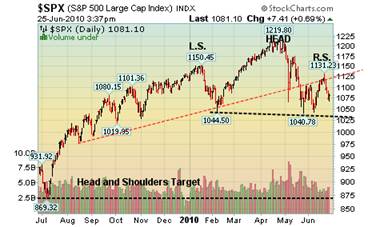 --Last week’s warning about trendline support becoming resistance was played out on Monday, as the S&P 500 index did an “oops” reversal at the trendline. A decline below 1040 may activate a new pattern, called a Head and Shoulders pattern. Once activated, it has a very high probability of meeting its target shown on the chart. For more info, here is contact information.
--Last week’s warning about trendline support becoming resistance was played out on Monday, as the S&P 500 index did an “oops” reversal at the trendline. A decline below 1040 may activate a new pattern, called a Head and Shoulders pattern. Once activated, it has a very high probability of meeting its target shown on the chart. For more info, here is contact information.
Treasury bond rally may be in trouble.
 -- The triangle pattern you see in the chart is usually a continuation pattern. However, if Treasuries cannot overcome their previous high at 125.97, we may see a technical breakdown. A breakout above that high may signal a continuation, but there is no assurance that it will happen. So bondholders, hope for the best and prepare for the worst.
-- The triangle pattern you see in the chart is usually a continuation pattern. However, if Treasuries cannot overcome their previous high at 125.97, we may see a technical breakdown. A breakout above that high may signal a continuation, but there is no assurance that it will happen. So bondholders, hope for the best and prepare for the worst.
Gold may also be in trouble.
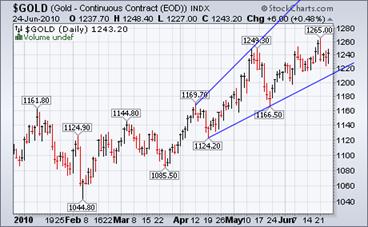 --Gold futures for delivery in August rose $9, or 0.7 percent, to $1,254.90 at 10:50 a.m. on the Comex in New York, narrowing the first weekly loss since mid-May. Earlier, the price touched $1,258, the highest level in four days.
--Gold futures for delivery in August rose $9, or 0.7 percent, to $1,254.90 at 10:50 a.m. on the Comex in New York, narrowing the first weekly loss since mid-May. Earlier, the price touched $1,258, the highest level in four days.
The rally in gold may be losing steam. In addition, the expanding formation shown in the chart becomes very unstable at this stage. Investors take caution.
Nikkei plunged back below 10,000.
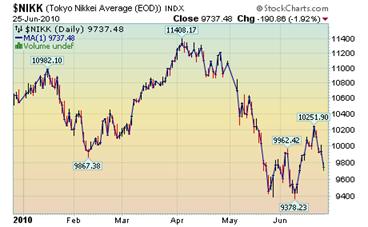 --Japanese stocks fell, dragging down the Nikkei index for a fourth straight day, as analyst rating cuts and U.S. profit forecasts raised concern about the strength of the recovery in the economy and earnings. The Nikkei 225 Stock Average fell 1.9 percent to 9,737.48 at the 3 p.m. close in Tokyo, the biggest decline among equity benchmarks in the Asia-Pacific region. The gauge closed below 10,000 for the sixth consecutive week.
--Japanese stocks fell, dragging down the Nikkei index for a fourth straight day, as analyst rating cuts and U.S. profit forecasts raised concern about the strength of the recovery in the economy and earnings. The Nikkei 225 Stock Average fell 1.9 percent to 9,737.48 at the 3 p.m. close in Tokyo, the biggest decline among equity benchmarks in the Asia-Pacific region. The gauge closed below 10,000 for the sixth consecutive week.
Can China stocks be building a base?
 -- China’s stocks fell for a third day, led by brokerages and industrial companies, on concern slowing economic growth will erode corporate earnings. The Shanghai Composite Index, which tracks the bigger of China’s stock exchanges, retreated 13.93, or 0.5 percent, to 2,552.82 at the close. The Shanghai gauge gained 1.6 percent this week after the central bank said it will increase the flexibility of the nation’s exchange rate.
-- China’s stocks fell for a third day, led by brokerages and industrial companies, on concern slowing economic growth will erode corporate earnings. The Shanghai Composite Index, which tracks the bigger of China’s stock exchanges, retreated 13.93, or 0.5 percent, to 2,552.82 at the close. The Shanghai gauge gained 1.6 percent this week after the central bank said it will increase the flexibility of the nation’s exchange rate.
Theres a lot of money betting against the dollar…who wins?
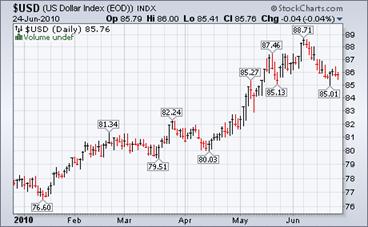 -- The dollar fell for a third day against a basket of six major currencies, heading for a weekly loss, as traders trimmed bets that the U.S. will boost interest rates this year. “Gold and the dollar are re-establishing their inverse relationship,” said Frank McGhee, the head dealer at Integrated Brokerage Services LLC in Chicago. “Investors are adjusting to the Fed’s rate outlook and the amount of liquidity that’s out there. A lot of assets are looking at a significantly lower dollar.”
-- The dollar fell for a third day against a basket of six major currencies, heading for a weekly loss, as traders trimmed bets that the U.S. will boost interest rates this year. “Gold and the dollar are re-establishing their inverse relationship,” said Frank McGhee, the head dealer at Integrated Brokerage Services LLC in Chicago. “Investors are adjusting to the Fed’s rate outlook and the amount of liquidity that’s out there. A lot of assets are looking at a significantly lower dollar.”
Mortgage rates hit an all time low. So what?
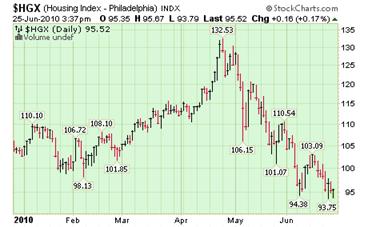 --Mortgage rates have hit an all-time low, but consumers are responding with a big "So what?" The average rate on a 30-year fixed-rate mortgage dropped to 4.69 percent this week from 4.75 percent last week, Freddie Mac reported Thursday. That marks the lowest level since the company started tracking the data in 1971 and breaks the most recent low set in December. Rates have hovered below 5 percent since early May.
--Mortgage rates have hit an all-time low, but consumers are responding with a big "So what?" The average rate on a 30-year fixed-rate mortgage dropped to 4.69 percent this week from 4.75 percent last week, Freddie Mac reported Thursday. That marks the lowest level since the company started tracking the data in 1971 and breaks the most recent low set in December. Rates have hovered below 5 percent since early May.
EIA needs a new script writer.
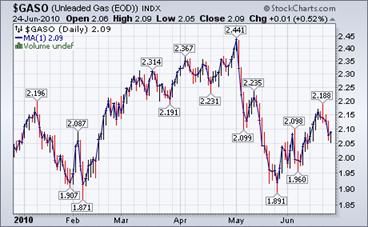 The Energy Information Agency weekly report observes, “For the first time in six weeks, the U.S. average price for regular gasoline increased, moving up four cents to settle at $2.74 per gallon, 5 cents higher than last year. Although prices went up in all regions of the country, the range of change was considerable, from less than a half cent in the Rocky Mountains to seven cents in the Midwest.”
The Energy Information Agency weekly report observes, “For the first time in six weeks, the U.S. average price for regular gasoline increased, moving up four cents to settle at $2.74 per gallon, 5 cents higher than last year. Although prices went up in all regions of the country, the range of change was considerable, from less than a half cent in the Rocky Mountains to seven cents in the Midwest.”
Natural Gas prices seeing downward pressure.
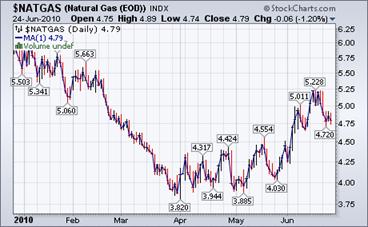 --. The U.S. Energy Information Administration reports, “Temperatures across much of the country soared as summer officially began this report week, boosting natural gas demand for electric power generation. The market received an early reminder of the 2010 Atlantic hurricane season on Monday and Tuesday of this week with the first tropical depression of the season potentially developing in the central Caribbean Sea. Furthermore, there are two hurricanes in the Pacific Ocean, Celia and Darby.”
--. The U.S. Energy Information Administration reports, “Temperatures across much of the country soared as summer officially began this report week, boosting natural gas demand for electric power generation. The market received an early reminder of the 2010 Atlantic hurricane season on Monday and Tuesday of this week with the first tropical depression of the season potentially developing in the central Caribbean Sea. Furthermore, there are two hurricanes in the Pacific Ocean, Celia and Darby.”
The First Intelligent Thing I've Heard From Bair.
(Denninger.net) For many decades U.S. government policies have promoted housing in general and homeownership in particular. These policies have been very successful in raising the quality of our housing stock while extending the benefits of homeownership to more than two-thirds of American households.
They have? Homeownership? Can you cite two states, for example, where one actually owns their real estate? (Hint: If you have to pay taxes on it every year in order to keep it, you don't actually own it. You're renting it - whether you have a note on it or not - from a government.)
There is no single fix that will restore confidence or immediately repair the dislocations that have taken place in housing and mortgage markets. But if we are willing to take bold steps, and return to the fundamentals of mortgage lending and securitization, we can get back to a more rational world where consumers are protected, risks are contained, and our scarce resources are allocated to their highest and best use.
Hmmm... that actually makes some sense. Wait a second... this is coming out of Bair's mouth?
US money supply plunges at 1930s pace as Obama eyes fresh stimulus…
(by Ambrose Evans-Pritchard) The M3 money supply in the United States is contracting at an accelerating rate that now matches the average decline seen from 1929 to 1933, despite near zero interest rates and the biggest fiscal blitz in history.
The M3 figures - which include broad range of bank accounts and are tracked by British and European monetarists for warning signals about the direction of the US economy a year or so in advance - began shrinking last summer. The pace has since quickened.
The stock of money fell from $14.2 trillion to $13.9 trillion in the three months to April, amounting to an annual rate of contraction of 9.6pc. The assets of institutional money market funds fell at a 37pc rate, the sharpest drop ever.
"It’s frightening," said Professor Tim Congdon from International Monetary Research. "The plunge in M3 has no precedent since the Great Depression. The dominant reason for this is that regulators across the world are pressing banks to raise capital asset ratios and to shrink their risk assets. This is why the US is not recovering properly," he said.
…which may be bigger than anyone previously thought.
Today’s article is even more revealing…Federal Reserve chairman Ben Bernanke is waging an epochal battle behind the scenes for control of US monetary policy, struggling to overcome resistance from regional Fed hawks for further possible stimulus to prevent a deflationary spiral.
"Key members of the five-man Board are quietly mulling a fresh burst of asset purchases, if necessary by pushing the Fed's balance sheet from $2.4 trillion (£1.6 trillion) to uncharted levels of $5 trillion."
(ZeroHedge writes) We are very curious where the DT's reporter has found this information, since if it comes from a credible source this is a massive game changer, and while many have speculated this will happen sooner or later, to know for a fact that QE is definitely coming is major news, and, if true, we are stunned the WSJ's Jon Hilsenrath, who recently has had his ear "very close" to the Fed's internal process, has not reported on this yet.
Traders alert: The Practical Investor is currently offering the daily Inner Circle Newsletter to new subscribers. Contact us at tpi@thepracticalinvestor.com for a free sample newsletter and subscription information.
Our Investment Advisor Registration is on the Web
We are in the process of updating our website at www.thepracticalinvestor.com to have more information on our services. Log on and click on Advisor Registration to get more details.
If you are a client or wish to become one, please make an appointment to discuss our investment strategies by calling Connie or Tony at (517) 699-1554, ext 10 or 11. Or e-mail us at tpi@thepracticalinvestor.com .
Anthony M. Cherniawski, President and CIO http://www.thepracticalinvestor.com
As a State Registered Investment Advisor, The Practical Investor (TPI) manages private client investment portfolios using a proprietary investment strategy created by Chief Investment Officer Tony Cherniawski. Throughout 2000-01, when many investors felt the pain of double digit market losses, TPI successfully navigated the choppy investment waters, creating a profit for our private investment clients. With a focus on preserving assets and capitalizing on opportunities, TPI clients benefited greatly from the TPI strategies, allowing them to stay on track with their life goals
Disclaimer: The content in this article is written for educational and informational purposes only. There is no offer or recommendation to buy or sell any security and no information contained here should be interpreted or construed as investment advice. Do you own due diligence as the information in this article is the opinion of Anthony M. Cherniawski and subject to change without notice.
Anthony M. Cherniawski Archive |
© 2005-2022 http://www.MarketOracle.co.uk - The Market Oracle is a FREE Daily Financial Markets Analysis & Forecasting online publication.



